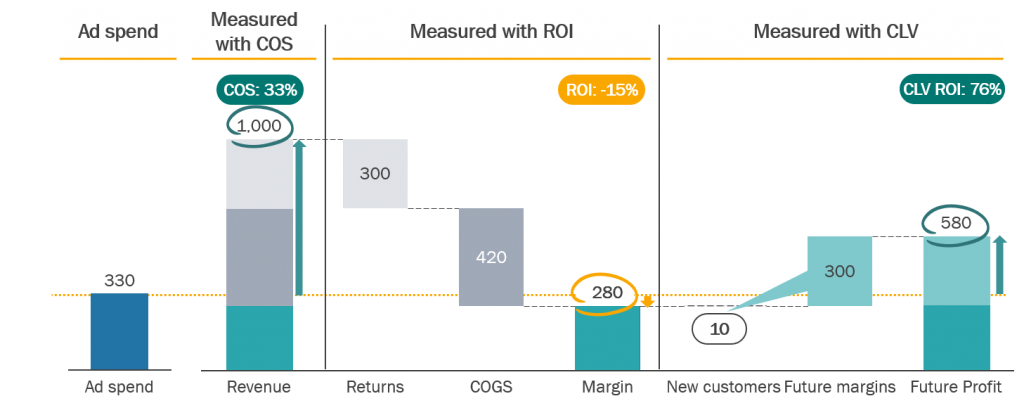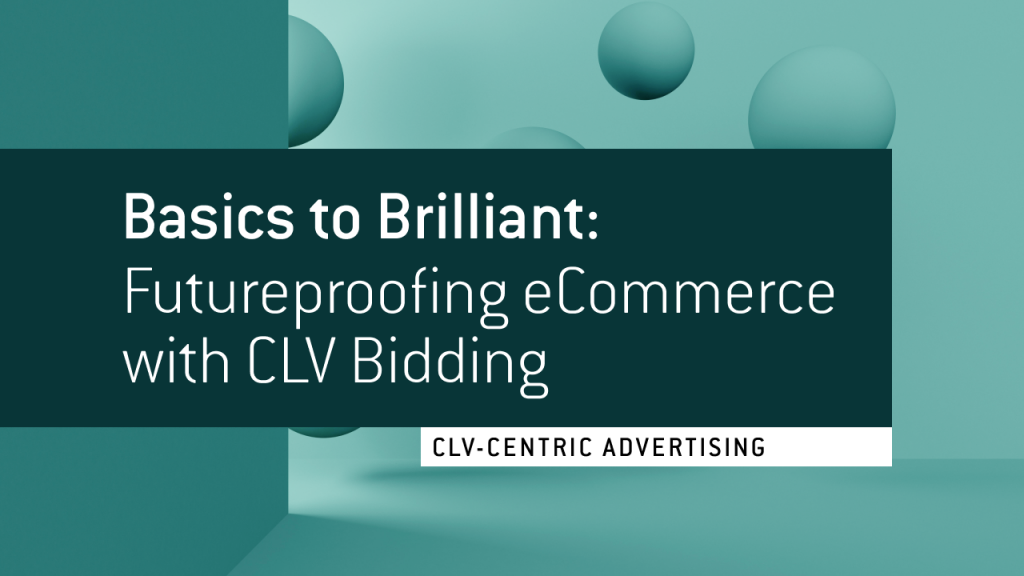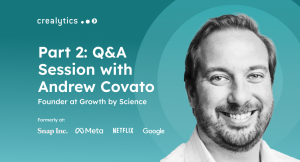Ideas and best practices move fast in search marketing. Yet one boasts some serious staying power. Customer Lifetime Value (CLV) remains the best metric to understand the overall impact of your performance advertising campaigns.
If you don’t already, CLV should be the KPI you aspire to as a retailer. Optimizing paid search campaigns for CLV helps retailers to future proof their profits. It reflects long-term investment and growth strategies; both in customer acquisition and marketing budgeting.
At Crealytics, we’ve been incorporating CLV into our optimization strategies for over 10 years. We discovered that advertisers who focus on long-term revenue goals make about five percent more revenue in the first 12 months, and can triple that number when they look over a longer time horizon.
What is Customer Lifetime Value?
Customer Lifetime Value is a performance measurement metric. It takes the acquisition of new customers into account – and values the future profits they generate alongside the initial cart value.
But understanding CLV isn’t the same as incorporating it into your search marketing campaigns. Whether it’s due to data availability, organizational roadblocks, or short term priorities, plenty of eCommerce companies still opt for more traditional, short-term metrics.
In this article, we’ll discuss overcoming these challenges and the four steps retailers must ascend on their path to CLV-based bidding. We’ll also learn why CLV trumps COS (cost of sale) or ROI-based measurements and how it influences bid management differently from a COS-based model.
Not all performance marketing metrics are created equal. Here’s why:
1: Measuring performance on a cost-per-order basis
Cost-per-order (CPO) forms the lowest rung on the metrics ladder. It measures the total cost associated with generating a single purchase, but fails to inform users of vital data points. Retailers can use it to understand the cost effectiveness of their marketing efforts. However, they still won’t know any of the revenues associated with each sale. Let’s take a CPO of $60. This would be perfectly fine for a TV worth $800. However, it would be a disaster if the item sold was a dress for $40. As an advertiser, if you sold 20 dresses but only two TVs, a CPO-based model would allocate more budget toward the dress!
2: Measuring performance based on cost-of-sale (COS)
Slightly higher up the chain comes COS (or Return on Ad Spend). Factoring in revenues unlocks a little more accuracy for retailers, who can calculate the relation between revenue and costs as a result. Decision-makers can at least optimize their campaigns based on past revenues. Because the revenue from the television sales vastly trumps that of the dress, retailers would allocate more budget to that campaign and away from the dress. But we still don’t really understand what role search marketing had in acquiring new customers or in driving profit.
3. Return on Investment
This metric delivers a healthy advantage over companies that use CPO and COS. Retailers who do so know not only their order and revenue, but the margins involved too. ROI calculates the exact profit at the time of order: the margin that remains after returns, cancellations and cost of goods sold (COGS). During sales periods, retailers might lower prices to a negative margin (in order to beat their competitors). If they sell a TV at a margin of $-50, but their dresses still have a positive margin of $10, they can still allocate budget towards the dresses despite an initially lower revenue. This model offers a healthier way of looking at search, but only provides a view on a per-transaction basis.
4. Customer Lifetime Value
Optimizing for profitability in the here and now is one thing. But retailers that optimize for CLV add in an estimation of what profits may be generated in the future. Say a retailer’s dresses attract more new customers than shirts. Even if the shirts have slightly higher margins, more budget will be allocated to dresses. Why? Because the profit generated through dresses over the next 12 months will be higher than the profit generated through the shirts.
COS wrongly portrays a picture of profitability. ROI shows actual profitability but only at the time of the order…

How does Customer Lifetime Value Work?
One of the reasons CLV works better than its predecessors stems from its focus on New Customers. Accounting for the acquisition of (and future profits from) this group helps retailers stand out from the crowd. Why New Customers? Because on average, new customers generate more profit than existing ones. They are more likely to return after making their first purchase and your other less expensive, organic marketing campaigns can do the heavy lifting once they are in the fold.
We’ve spoken before about efficiency versus effectiveness in paid search. For retailers who focus on ROAS or ROI see their budget flow towards branded terms or RLSA. After all, these areas boast better conversion rates. They cost less. They are more efficient.
They also come shackled to a big problem. Retailers who shoot for efficiency sacrifice future expansion. Yes, keeping hold of existing customers remains important.
But new customers (NC) fuel a company’s growth. It costs more to attract this group. And they bring much more value. Unlike efficient-friendly brand terms or RLSA, advertisers can snag new customers using upper-funnel channels like Non-branded text ads, Shopping or Programmatic Display. In this respect, must those retailers used to doing things the old way have to set new expectations?
Can they stomach allocating budget towards areas that just aren’t as efficient in exchange for greater long-term gains? Is the organization willing to sacrifice short term, yet unsustainable, revenue in return for longer term profitability and a healthier customer portfolio?
CLV can illustrate the benefits waiting for those retailers prepared to take a leap of faith. You add the profit a new customer will generate over their lifetime in the future to the profit of the first purchase. By doing so, budgets can be allocated to channels that maximize profit over a longer time horizon. For example:
- Customers that come in through PPC generate:
- 12 months: purchase 1.8 times on average with a profit of *$30
- 24 months: purchase 2.2 times with a profit of $50
- 36 months: purchase 2.5 times with $65 profit
- The client wants to be profitable after 12 months.
- The 12 months profit is added to each purchase made by a new customer:
- Ad spend: $300 | Margin: $280 = Negative ROI, unprofitable
- Ad spend: $300 | Margin: $280 + Future profit: $300 (10 NC* LTV $30) = Total profit: 580$, positive CLV ROI after 1 year
→ More budget can be invested in this channel because high NC rate leads to higher profits after 1 year than a channel with low NC rate would generate
→ The higher the budget, the more new customers, the lower the initial profit, but the higher the future profit
*This future profit already includes any future advertising costs
How does CLV influence bid management?
By its very nature, bid management assigns higher bids to products or keywords with higher earnings. Therefore, bid platforms will automatically assign higher bids to products or keywords that generate more new customers.
- Product A: Cost $300 | Margin $350 | NC profit $300 → Total profit $650 (before ad spend)
- Product B: Cost $300 | Margin $350 | NC profit $100 → Total profit $450 (before ad spend)
→ Product A has higher earnings, therefore receives a higher bid. With an ROI model both products would have received the same bid as they have the same margin at the same cost.
Today, most automated bidding solutions optimize towards a fixed ROAS efficiency target. In this scenario, Customer Lifetime Value can only be implicitly applied. By accepting overall lower ROAS targets and therefore using higher budgets, companies assume to also attract more new customers.
But without precise new customer tracking to validate such assumption, this approach becomes flawed. In a worst-case scenario, the increased ad spend triggers non-incremental repeat purchases, destroying the myth of ever-decreasing marketing costs with every follow-up transaction.
Automated Bid Management systems can only reach the next level of maturity when they work on conversion data that differentiates between the first transaction of a new customer and repeat purchases. Typically, only a CRM system can tell which of the two happened. And connecting conversion tracking to CRMs presents a challenge to Digital Marketing – it requires development resources from the IT department.
The next challenge is to assign different value tags. Automated bid management solutions are driven by data – as opposed to managers, whose decisions are supported by data. Automated Bidding systems hence need incentives to spend more on campaign segments that drive new customers. This can be done by modelling different conversion values. The conversion value of a transaction from a new customer needs to be increased; it needs to be decreased for a repeat purchase.
But by how much? Customizing conversion values in Bid Management requires not just a firm appreciation of data science, but a generous chunk of change management, too.
Want more information on applying CLV-bidding to your campaigns? Check out our video series on performance metrics here.





1 thought on “Basics to Brilliant: Futureproofing eCommerce with CLV bidding”
It’s hard to find experienced people for this topic, but you seem like you know what you’re talking about!
Thanks